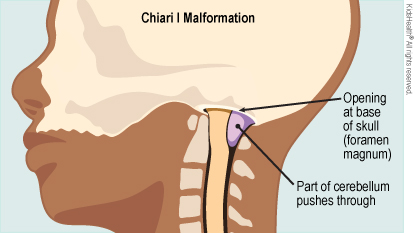Chiari I malformation (key-AR-ee mal-for-MAY-shun) is when the cerebellum — the part of the brain that controls coordination and muscle movement — pushes down through the hole in the bottom of the skull. This hole is called the foramen (fer-AY-men) magnum.
Many kids with Chiari I malformation have no symptoms. If symptoms do happen, they usually don't show up until late childhood or the teen years. Treatment can help kids who do have them.


Follow your health care provider's instructions for:

Your child has any of these symptoms:


What causes Chiari I malformation? Doctors don't know exactly what causes Chiari I malformation. A baby can be born with it or develop it in the first few years of life. Less often, it can happen later in life from trauma, infection, or other medical problems.
Chiari I malformation can run in families. So it may have a genetic cause.
Can other problems happen with a Chiari I malformation? Sometimes, children with Chiari I malformation can also have:
How is a Chiari I malformation treated? For kids without symptoms, doctors usually recommend getting follow-up MRIs to check for any changes. Surgery usually isn't needed.
For children with severe symptoms, doctors often recommend a surgery called posterior fossa decompression. This surgery makes more space for the cerebellum and lowers pressure on the spinal cord.